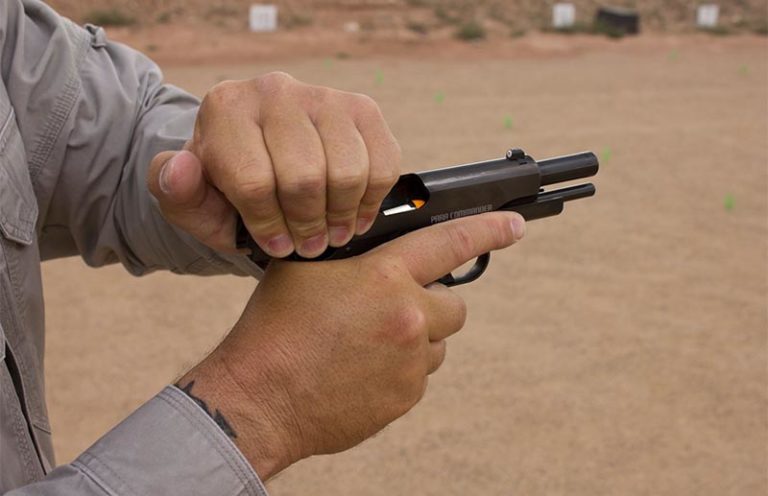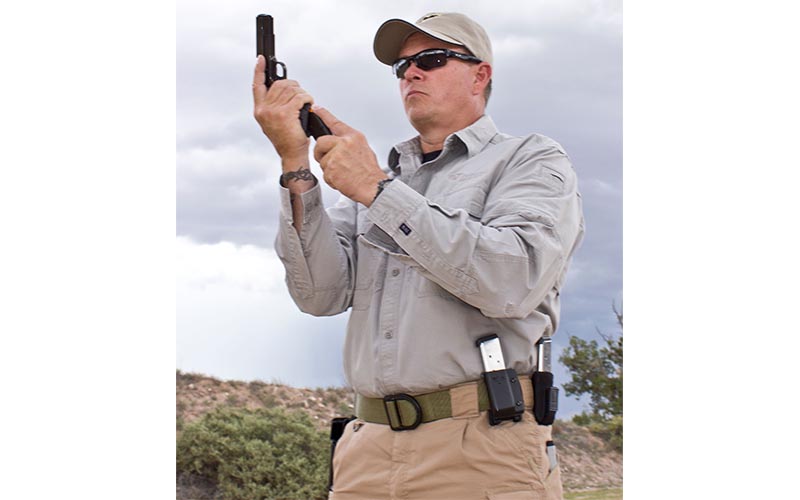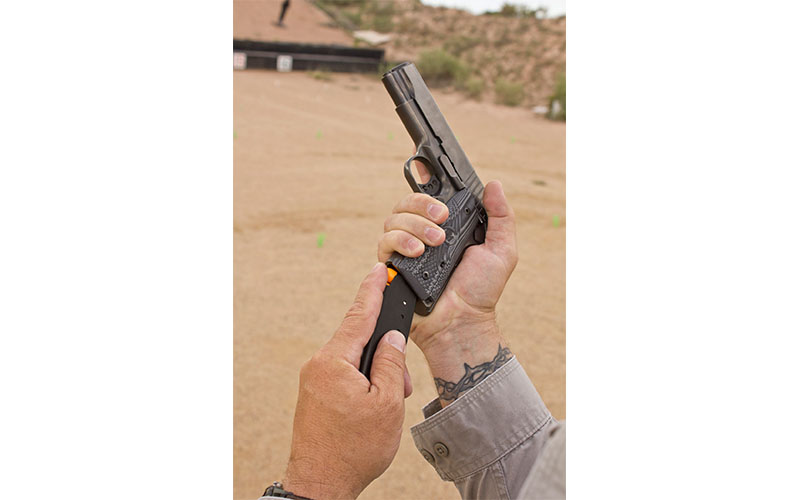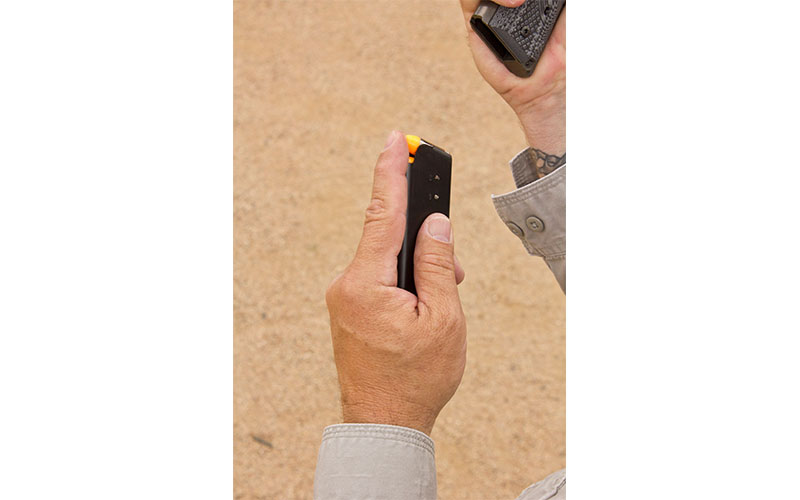
If you don’t want to be caught with an empty gun, it’s time to master the administrative, tactical and speed reloads.
The reloading of a defensive handgun is generally considered a baseline skill. It’s something that every defensive handgun training course I’ve taken spends a good bit of time teaching. This makes sense because an empty gun is mostly useless. Most doctrine separates reloading into three techniques. These include the administrative reload, the tactical reload and the speed reload. Although all three serve the same purpose of keeping your handgun full of ammunition, they have different application.

Administrative Reloads
Administrative reloading is something that has no tactical value. It’s nothing but the administrative steps you take when you’re readying your pistol for carry, or when you get to the range and are readying your pistol for training … though you do often see it used during handgun training courses when students step off the line to load magazines and take a break. Often, shooters will remove the magazine from a holstered handgun and top it off and reinsert it. Or, they’ll be standing on the line and adjusting ammunition within magazines and the magazine within the pistol to prepare for a specific exercise or drill.
With the understanding that sometimes, for specific drills, you need a certain round count in one or more magazines, I’m not a fan of the administrative reload. When you complete an exercise or drill on the range and are going to take a break to rest or load magazines, you should first conduct a tactical reload so that the handgun in your holster is fully loaded. The conduct of an administrative reload should only be done to establish some drill, training or safety requirement.

Tactical Reloads
This reloading technique is one that’s conducted when you have time. Often, it’s suggested that you conduct a tactical reload during a lull in the action. I’m not sure how to precisely define “a lull in the action,” but I am sure of two things: 1) the more ammunition you have in your gun, the better off you are; and 2) you should never holster a handgun that’s not fully loaded, because if you need it—really need it—it needs to be fully loaded.
With the tactical reload, you retain the magazine you eject from your handgun because you haven’t fully expended the ammunition that’s in it, and you understand that you might need to use that ammunition latter on.
When is a tactical reload applicable? It’s nearly impossible to offer any hard and fast rules because the chaos that surrounds a self-defense shooting doesn’t lend itself to absolutes. So, look at it this way: If you need to conduct a reload because you’ve depleted your ammunition supply, and you have time to retain the magazine that is in the gun, then do so. Otherwise, a speed reload is more appropriate.
More practically and most assuredly, the tactical reload should be conducted after an engagement, but before holstering. You’ve solved the immediate problem and have the time to retain any unexpended ammo in the current magazine—while at the same time making sure that you holster a fully loaded pistol.

Speed Reloads
This reloading technique is used when you need to get more ammunition in your gun as swiftly as possible. It could be that you’ve expended a large portion of your on-board ammunition and want to be fully loaded for the impending doom that’s quickly approaching you. It could be conducted because you’ve expended all the ammunition in your gun and need more ammo immediately. And the speed reload could also be conducted because your handgun has stopped working, either because it’s out of ammo or has maybe experienced a stoppage.
With the speed reload, the magazine in your gun is ejected and allowed to drop free without concern of where it lands or if you’ll ever see it again. It’s often taught that when conducting a speed reload, you should pull the handgun back into your workspace, hold it up high where you can look through it and still see the threat, and peripherally see the insertion of the new magazine. This makes sense if you’re standing in front of a threat while trying to reload—but standing in front of a threat while trying to reload makes no sense.
Conducting a speed reload while moving or utilizing cover does make sense.
Regardless of the particulars associated with the speed reload, the primary directive is to get the gun reloaded as fast as possible.

Additional Considerations
Ideally, when you utilize any method to reload a pistol, you should take the time to verify that the reload was conducted properly. This means you should conduct a press check and either visually or tactilely confirm a cartridge was inserted into the chamber … and that the magazine is fully seated. Granted, if you’re conducting a speed reload, there might not be time to do this, but it’s something that there should always be time for if you’re conducting an administrative or tactical reload.
If you’ve conducted an administrative or tactical reload, the placement of the partially loaded magazine that was removed from the handgun is important. It shouldn’t be placed in your primary ammunition pouch or storage location unless it’s the only remaining magazine that you have. Otherwise, you might be reaching for what you think is a full magazine, only to grasp the partially expended magazine. The partially expensed magazine should be placed in an alternate location that can be easily accessed by your support hand in case you need it.
Editor's Note: This article originally appeared in the April 2022 issue of Gun Digest the Magazine.
More On Handgun Skills And Training:
- Video: Target Transition Training With The Dot Drill
- The Shot Timer And Defensive Handgun Training
- Gun Digest’s 10 Best Shooting Drills And Firearms Training Posts
- MantisX: Simple And Effective Training
- Video: Is A Full-Sized Pistol The Best Training Option?

Next Step: Get your FREE Printable Target Pack
Enhance your shooting precision with our 62 MOA Targets, perfect for rifles and handguns. Crafted in collaboration with Storm Tactical for accuracy and versatility.
Subscribe to the Gun Digest email newsletter and get your downloadable target pack sent straight to your inbox. Stay updated with the latest firearms info in the industry.

![Best Concealed Carry Guns In 2025 [Field Tested] Wilson Combat EDC X9S 1](https://gundigest.com/wp-content/uploads/Wilson-Combat-EDC-X9S-1-324x160.jpg)


![Best 9mm Carbine: Affordable PCCs [Tested] Ruger Carbine Shooting](https://gundigest.com/wp-content/uploads/Ruger-Carbine-Shooting-100x70.jpg)
![Best AR-15: Top Options Available Today [Field Tested] Harrington and Richardson PSA XM177E2 feature](https://gundigest.com/wp-content/uploads/Harrington-and-Richardson-PSA-XM177E2-feature-100x70.jpg)
